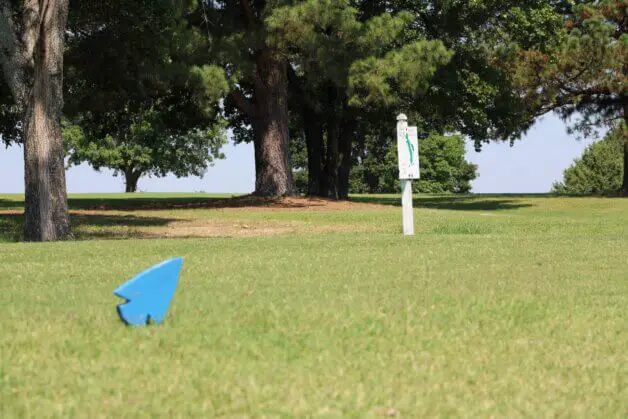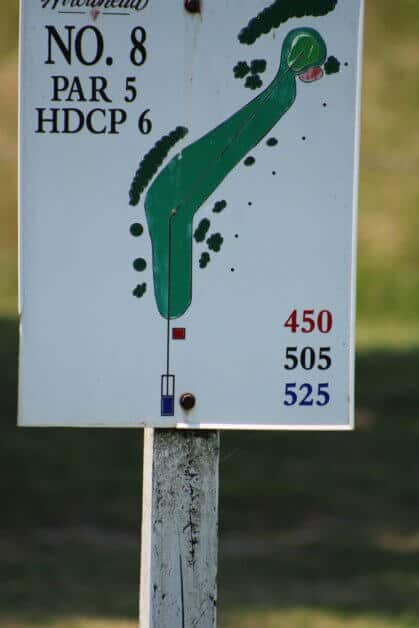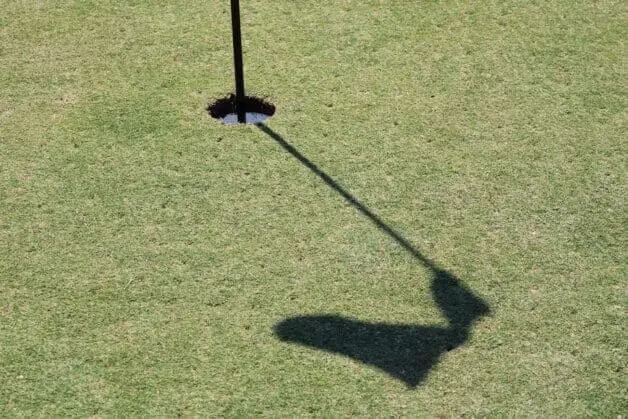The golf scorecard is a critical document in the golf game. Besides your ability to play the game and know the rules, knowing how to read a golf scorecard and completing your card is the third crucial element in the sport.
At most golf courses a scorecard asks for information and gives many golfers information like hole distance, the hole par score, the handicap or stroke for each hole, the course rating, and spaces for your score on individual holes and the total score.

Knowing what each line means, what it’s telling you, and what information you need to input for the card to be handed in and legally scored is what this discussion is all about. All this adds up to keeping score in golf.
The Scorecard Layout
The golf score card is usually a card stock folded with the various elements of the golf holes laid out horizontally across the card in columns. It’s foldable so that you can fit it into your pocket, onto your golf trolley, or on the golf cart steering wheel.
When learning how to read a golf score card for a standard golf course you will notice there are nine hole numbers across the card to the fold and another nine from the middle to the end. The 9th hole marks the end of the ‘out’ section of the play, and the 18th hole marks the end of the ‘in’ section of the play.

Remember that not all scorecards are the same, so the info you get here may vary its position on the card, but it should all be there. These are the standard sections on a golf card.
The one box not included here is the ‘name of player’ box as this requires no explanation.
1. Hole Number
2. Tee Colors
3. Yardage
4. Par
5. Player’s Handicap
6. Slope Number Rating And Course Rating
Now, to understand how to read a scorecard, let’s look at each of these individually and what they mean.
1. Hole Number – In And Out
This block on a golf scorecard is numbered from 1-18 on a standard 18 hole course. The golf course is divided into the ‘In’ and the ‘Out’ sections. The ‘Out’ section is the first nine holes where you play away from the clubhouse, and the ‘In’ section is the last nine holes where you play back to the clubhouse.

You would usually play from hole 1 to hole 9 and then from hole 10 to hole 18. There are times when you would play this in reverse, but either way, you will still complete the round.
2. Tee Box Colors
On the left side of the golf scorecard, you will see a set of colors, each with a different name. The standard ones are usually green tees, blue tee boxes, red tees (often known as ladies tees), white tees, or gold tees, but some regulation golf course may use different colors to identify each tee.

The differences in the colors indicate which tees should be used depending on the skill and/or age and/or gender of each player.
For example, the white tees or blue tees are usually the set that the average or beginner golfers will play from; the gold tees could be the back tees reserved for competitions or lower handicapped players, while the red tees are usually reserved for ladies.
There would also be green tees reserved for senior players. Each color tee has slightly separate yardages based on the level of golfer allocated to those tees.
3. Golf Course Yardage
The next set of numbers will be the distances on each hole from the color of the tee. This will vary depending on the player, so if you are an average male player, then your white tee distances will be longer on average than the ladies tee or the senior tee distances.

The yardage will indicate the distance from the tee to the middle of the green, and these may vary a little from the actual yardages on each particular hole.
Every so often, the golf course will ‘recalibrate’ or ‘remeasure’ the yardages on the card using the latest GPS systems to give their players more accurate distance measurements. This can also happen when courses are looking to redesign or update their scorecards.
Some courses may even have the hole layout diagram on the scorecard, showing the positions of hazards and distances from the tee to specific hazards or reference points on the fairway.
4. Par Score
This number indicates the desired score on the hole for a good player. On a standard par 72 course, you would have ten par 4’s, four par 5’s, and four par 3’s. These numbers indicate the ideal number of strokes required to complete that hole.
So three shots for a par 3, four for a par 4, and five for a par 5. Each nine would have these holes divided equally, so the front nine would have five par 4’s, two par 5’s, and two par 3’s.
5. The Hole Handicap Or Stroke
This number indicates the difficulty of the hole rated from 1 -18. A hole rated golf handicap of 1 is the hardest hole, while a hole rated 18 is the easiest.

This number is there so that golfers play in relation to their handicap, and this evens out the match where players of different abilities play against each other. Handicaps are often used in golf tournaments for amateur players and are established by the United States Golf Association.
It is a complex system, but here is a simple example. A player who holds an 18 handicap would deduce one shot from each hole to calculate his net score. The gross score is the total number of strokes played in a round.
The net score is the final total after deducting the allowed handicap strokes.
6. Golf Courses Slope Rating And Course Rating
These numbers are there to show the player the difficulty of the golf course as a whole. The higher the average slope rating, the more difficult the course would be for a bogey or average player.

For example, an average slope rating of 95 will be easier than a slope rating of 130.
The rating is the score that a par or scratch golfer would be expected to shoot. A scratch player would make par on most holes on the course with the occasional birdie and bogey evening out the scoring.
On a par 72 course with a course rating of 74, a scratch player would be expected to shoot 74 or two over par, indicating that the course is challenging. If that course rating is lower, say 70, then that same player would be expected to shoot around 72 or lower, indicating that the course is playing easier.

You could have the same length course but with different ratings, as one may have narrow tight fairways, rippling greens, and difficult rough with plenty of hazards, while the other may have wide-open fairways with few hazards and flattish greens.
Now that you have a grasp of the numbers let’s take a quick look at marking your card.
Marking Your Golf Scorecard
The first step is to fill in your name and the names of the players in your group. Then, as you progress from hole to hole, fill in the score on each hole after completion. This should be done honestly to get a correct score and indication of how well you played.
At the end of the first nine, whether it’s ‘In’ or ‘Out,’ tally up the scores for each player and mark in the respective block for that nine. Then, do the same with the next nine holes.
Once the round is done, you can add up the second nine scores for each one and get to the gross score. The deduct the handicap of each player to calculate the net score and complete the scoring by putting both scores in their respective blocks.
Handing In Your Scorecard
Before handing it in, make sure you sign it as the player and the marker, especially if you are playing competition; failure to sign your card will get you disqualified. Similar to how pro golfers keep score and turn in their scorecards.
This part doesn’t have to be done for casual rounds, but if you want to play the game properly, then learning how to read a golf score card and mark your golf card properly is the way to go.
- Should Tee Boxes Be Level? - January 23, 2024
- 3 Hybrid Distance - November 15, 2023
- Innovations in Golf Mobility: An In-depth Review of Top Golf Scooters - October 12, 2023
